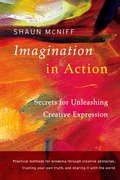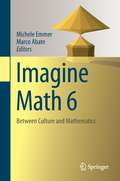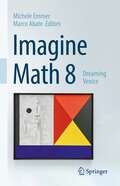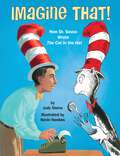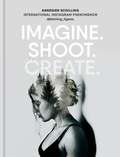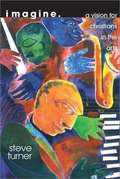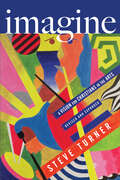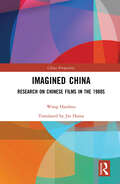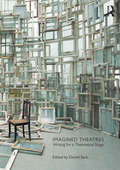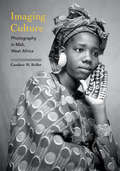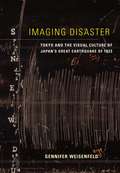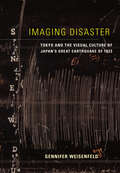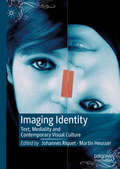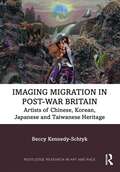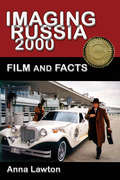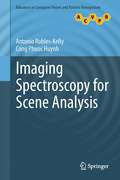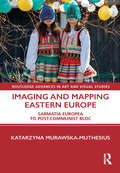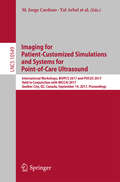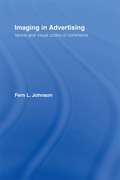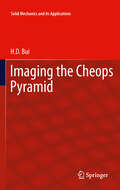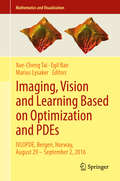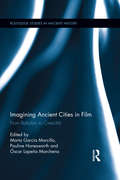- Table View
- List View
Imagination in Action: Secrets for Unleashing Creative Expression
by Shaun McniffHe's spent a career helping people access their creative potential, and now Shaun McNiff is sharing the secrets he's learned from observing his own creative process as well as that of others--both those who identify as artists and those who don't. The result is nothing less than a master class in creativity by one of the great creative theorists--and practitioners--of our time. "This is intended as a practical text," Shaun says, "a creativity primer, striving to capture the essential things that have been of use to me and others." The wealth of instruction he provides here in these essential things will be indispensable to artists of all stripes, as well as to all who strive to express themselves with honesty and authenticity using any of the media life makes available.
Imagine Math 6: Between Culture And Mathematics
by Michele Emmer Marco AbateImagine mathematics, imagine with the help of mathematics, imagine new worlds, new geometries, new forms. Imagine building mathematical models that make it possible to manage our world better, imagine combining music, art, poetry, literature, architecture and cinema with mathematics. Imagine the unpredictable and sometimes counterintuitive applications of mathematics in all areas of human endeavour. Imagination and mathematics, imagination and culture, culture and mathematics.This sixth volume in the series begins with a homage to the architect Zaha Hadid, who died on March 31st, 2016, a few weeks before the opening of a large exhibition of her works in Palazzo Franchetti in Venice, where all the Mathematics and Culture conferences have taken place in the last years. A large section of the book is dedicated to literature, narrative and mathematics including a contribution from Simon Singh. It discusses the role of media in mathematics, including museums of science, journals and movies. Mathematics and applications, including blood circulation and preventing crimes using earthquakes, is also addressed, while a section on mathematics and art examines the role of math in design. A large selection presents photos of mathematicians and mathematical objects by Vincent Moncorge. Discussing all topics in a way that is rigorous but captivating, detailed but full of evocations, it offers an all-embracing look at the world of mathematics and culture.
Imagine Math 8: Dreaming Venice
by Michele Emmer Marco AbateThis eighth volume of Imagine Math is different from all the previous ones. The reason is very clear: in the last two years, the world changed, and we still do not know what the world of tomorrow will look like. Difficult to make predictions. This volume has a subtitle Dreaming Venice. Venice, the dream city of dreams, that miraculous image of a city on water that resisted for hundreds of years, has become in the last two years truly unreachable. Many things tie this book to the previous ones. Once again, this volume also starts like Imagine Math 7, with a homage to the Italian artist Mimmo Paladino who created exclusively for the Imagine Math 8 volume a new series of ten original and unique works of art dedicated to Piero della Francesca. Many artists, art historians, designers and musicians are involved in the new book, including Linda D. Henderson and Marco Pierini, Claudio Ambrosini and Davide Amodio. Space also for comics and mathematics in a Disney key. Many applications, from Origami to mathematical models for world hunger. Particular attention to classical and modern architecture, with Tullia Iori.As usual, the topics are treated in a way that is rigorous but captivating, detailed and full of evocations. This is an all-embracing look at the world of mathematics and culture.
Imagine That!: How Dr. Seuss Wrote The Cat in the Hat
by Judy SierraA lively new picture-book biography of the most beloved children&’s book author of all time: Dr. Seuss!Have you ever wondered how the great Dr. Seuss wrote his most famous book? Did you know that for The Cat in the Hat, he wasn&’t allowed to make up the fun words he was known for—like OOBLECK and IT-KUTCH and HIPPO-NO-HUNGUS? He was only allowed to use words from a very strict list! This bouncy account of the early career of Dr. Seuss (a.k.a. Ted Geisel) proves that sometimes limitations can be the best inspiration of all. Kid-friendly prose (with Seussian rhyme for Ted&’s dialogue) and whimsical illustrations by award winner Kevin Hawkes recall the work of Dr. Seuss himself. Writing tips from Dr. Seuss and exclusive letters from the author and illustrator, detailing how they created this book, are included!
Imagine a City That Remembers: The Albuquerque Rephotography Project (Querencias Series)
by Mark C. Childs Anthony AnellaImagine a City That Remembers grew out of a series of articles and photographs published in the Albuquerque Tribune in 1998 and 1999. This expanded and updated collection revisits Albuquerque nearly twenty years after the original articles were written. It juxtaposes historic and contemporary photographs of Albuquerque to show diverse moments in the city&’s history and development. The authors, ardent defenders of the vitality of Albuquerque&’s past, contend that the city is still small enough to be in touch with its history and argue that what makes Albuquerque a great place is the continued presence of its strong traditions. They further believe that preserving Albuquerque&’s natural and cultural heritage is critical to the city&’s future. Throughout, both express a deep understanding for this complicated, beautiful, and often misunderstood place.
Imagine. Shoot. Create.: Creative Photography
by Annegien SchillingAnnegien Schilling started her @fetching_tigerss Instagram account when she was 13 years old. Six years later, she has almost 1 million followers worldwide. Her distinctive, surreal images inspire curiosity about the creative process, and in this book, Annegien shares her signature editing style in great detail. She guides her readers through simple step-by-steps to beautiful, surreal imagery and teaches her successful method of conceiving an idea (Imagine), capturing it correctly (Shoot), and editing them efficiently (Create), all without expensive camera gear or complicated software. This book will inspire you to explore your imagination and create photos you never thought possible!
Imagine. Shoot. Create.: Creative Photography
by Annegien SchillingAnnegien Schilling's imaginative self-portraits inspire just under 1 million followers under the account @fetching_tigerss. In this, her first book, she guides her readers through simple step-by-steps to beautiful, surreal imagery and teaches her successful method of conceiving an idea (Imagine), capturing it correctly (Shoot), and editing them efficiently (Create), all without expensive camera gear or complicated software. This book will inspire you to explore your imagination and create photos you never thought possible!
Imagine: A Vision for Christians in the Arts
by Steve TurnerImagine music, movies, books and paintings of the highest quality! Imagine art that permeates society, challenging conventional thinking and standard morals to their core! Imagine that it is all created by Christians! This is the bold vision of Steve Turner, someone who has worked among artists--many Christian and many not--for three decades.
Imagine: A Vision for Christians in the Arts
by Steve TurnerImagine art that is risky, complex, and subtle. Imagine music, movies, books, and paintings of the highest quality. Imagine art that permeates society, challenging conventional thinking and standard morals to their core. Imagine that it is all created by Christians! This is the bold vision of Steve Turner, who has worked among a wide variety of artists for decades. He believes Christians should confront society and the church using art's powerful impact. Art can faithfully chronicle the lives of ordinary people and express the transcendence of God. And Christians should be involved in every level of the art world and in every medium. In this revised and expanded edition of a contemporary classic, Turner builds a compelling case for Christians in the arts. If Jesus is Lord of all of life and creation, then art is part of his cultural mandate. It can and should be a way of expressing faith through creatively, beautifully, and truthfully arranged words, sounds, and sights. Now includes study questions for individual reflection or group discussion.
Imagined China: Research on Chinese Films in the 1980s (China Perspectives)
by Wang HaizhouThis book explores how Chinese films constructed an image of China in the 1980s through analyzing the characters, composition of space, and conflict patterns of the films. It also examines the relationship between the representations in Chinese cinema and the realities of Chinese society. The study analyzes the imagery, metaphors, and cultural values of Chinese films in the 1980s to discover the common creative focus of Chinese film directors at the time. It also examines the specific creative elements and cultural significance of Chinese cinema in the 1980s. This book is neither a “period history” of Chinese cinema in the 80s, nor a thematic study of the “fifth generation”. Rather, it is an analysis of films as narrative texts that reflected on history. It uses the perspectives revealed by characters, narrative patterns, and conflicts in films of the 1980s to examine how the era was perceived at that time as well as how China’s national future and individuals’ personal futures were being conceptualized. This title will be a valuable resource for scholars and students of Chinese Studies, Contemporary China Studies, Film Studies, and those who are interested in Chinese culture and society in general.
Imagined Theatres: Writing for a Theoretical Stage
by Daniel SackImagined Theatres collects theoretical dramas written by some of the leading scholars and artists of the contemporary stage. These dialogues, prose poems, and microfictions describe imaginary performance events that explore what might be possible and impossible in the theatre. Each scenario is mirrored by a brief accompanying reflection, asking what they might mean for our thinking about the theatre. These many possible worlds circle around questions that include: In what way is writing itself a performance? How do we understand the relationship between real performances that engender imaginary reflections and imaginary conceptions that form the basis for real theatrical productions? Are we not always imagining theatres when we read or even when we sit in the theatre, watching whatever event we imagine we are seeing?
Imaging Culture: Photography in Mali, West Africa (African Expressive Cultures)
by Candace M. KellerImaging Culture is a sociohistorical study of the meaning, function, and aesthetic significance of photography in Mali, West Africa, from the 1930s to the present. Spanning the dynamic periods of colonialism, national independence, socialism, and democracy, its analysis focuses on the studio and documentary work of professional urban photographers, particularly in the capital city of Bamako and in smaller cities such as Mopti and Ségu. Featuring the work of more than twenty-five photographers, it concentrates on those who have been particularly influential for the local development and practice of the medium as well as its international popularization and active participation in the contemporary art market. Imaging Culture looks at how local aesthetic ideas are visually communicated in the photographers' art and argues that though these aesthetic arrangements have specific relevance for local consumers, they transcend geographical and cultural boundaries to have value for contemporary global audiences as well. Imaging Culture is an important and visually interesting book which will become a standard source for those who study African photography and its global impact.
Imaging Disaster
by Gennifer WeisenfeldFocusing on one landmark catastrophic event in the history of an emerging modern nation--the Great Kant? Earthquake that devastated Tokyo and surrounding areas in 1923--this fascinating volume examines the history of the visual production of the disaster. The Kant? earthquake triggered cultural responses that ran the gamut from voyeuristic and macabre thrill to the romantic sublime, media spectacle to sacred space, mournful commemoration to emancipatory euphoria, and national solidarity to racist vigilantism and sociopolitical critique. Looking at photography, cinema, painting, postcards, sketching, urban planning, and even scientific visualizations, Weisenfeld argues that that visual culture has powerfully mediated the evolving historical understanding of this major national disaster, ultimately enfolding mourning and memory into modernization.
Imaging Disaster: Tokyo and the Visual Culture of Japan's Great Earthquake of 1923 (Asia: Local Studies / Global Themes)
by Gennifer WeisenfeldFocusing on one landmark catastrophic event in the history of an emerging modern nation—the Great Kanto Earthquake that devastated Tokyo and surrounding areas in 1923—this fascinating volume examines the history of the visual production of the disaster. The Kanto earthquake triggered cultural responses that ran the gamut from voyeuristic and macabre thrill to the romantic sublime, media spectacle to sacred space, mournful commemoration to emancipatory euphoria, and national solidarity to racist vigilantism and sociopolitical critique. Looking at photography, cinema, painting, postcards, sketching, urban planning, and even scientific visualizations, Weisenfeld demonstrates how visual culture has powerfully mediated the evolving historical understanding of this major national disaster, ultimately enfolding mourning and memory into modernization.
Imaging Identity: Text, Mediality and Contemporary Visual Culture
by Johannes Riquet Martin HeusserThis volume explores the many facets and ongoing transformations of our visual identities in the twentieth and twenty-first centuries. Its chapters engage with the constitution of personal, national and cultural identities at the intersection of the verbal and the visual across a range of media. They are attentive to how the medialities and (im)materialities of modern image culture inflect our conceptions of identity, examining the cultural and political force of literature, films, online video messages, rap songs, selfies, digital algorithms, social media, computer-generated images, photojournalism and branding, among others. They also reflect on the image theories that emerged in the same time span—from early theorists such as Charles S. Peirce to twentieth-century models like those proposed by Roland Barthes and Jacques Derrida as well as more recent theories by Jacques Rancière, W. J. T. Mitchell and others. The contributors of Imaging Identity come from a wide range of disciplines including literary studies, media studies, art history, tourism studies and semiotics. The book will appeal to an interdisciplinary readership interested in contemporary visual culture and image theory.
Imaging Migration in Post-War Britain: Artists of Chinese, Korean, Japanese and Taiwanese Heritage (Routledge Research in Art and Race)
by Beccy Kennedy-SchtykThis book examines the artistic practices of a range of British-based artists of East Asian (Chinese, Japanese, Korean and Taiwanese) heritage to consider the social, political and cultural effects of migration or diaspora on their creative production. Beccy Kennedy-Schtyk demonstrates three themes: the multiplicity and expansive contemporaneity of these artists’ visual oeuvres; the physical impact or interpretation of migratory circumstances on their artistic practices; and the necessity to continue to evolve ways of thinking about migration, race and border crossings in the current political climate of the 21st century. The book will be of interest to scholars studying art history, Asian studies, British studies, migration and diaspora studies, and cultural studies.
Imaging Migration in Post-War Britain: Artists of Chinese, Korean, Japanese and Taiwanese Heritage (Routledge Research in Art and Race)
by Beccy Kennedy-SchtykThis book examines the artistic practices of a range of British-based artists of East Asian (Chinese, Japanese, Korean and Taiwanese) heritage to consider the social, political and cultural effects of migration or diaspora on their creative production.Beccy Kennedy-Schtyk demonstrates three themes: the multiplicity and expansive contemporaneity of these artists’ visual oeuvres; the physical impact or interpretation of migratory circumstances on their artistic practices; and the necessity to continue to evolve ways of thinking about migration, race and border crossings in the current political climate of the 21st century.The book will be of interest to scholars studying art history, Asian studies, British studies, migration and diaspora studies, and cultural studies.
Imaging Russia 2000: Film and Facts
by Anna Lawton“[A] sparkling and original work . . . I can think of no better guide to the heart of post-Soviet urban Russia than this entertaining and refreshing book.” —Richard Stites, Professor of History, Georgetown UniversityThis book incorporates into an organic whole the realities of the 1990s in Russia, focusing on film production, the films themselves, and the socio-political-cultural context. It aims to provide a picture of Russia (with Moscow in the foreground) as the big stage on which the drama unfolded. The author discusses some eighty films made between 1990 and 2000. Many reflect the reality of the present day, either in dramatic or grotesque form. Others reassess the past, placing different spins on various epochs and figures according to the director’s ideological orientation. Still others offer escapism into imaginary worlds. The films selected may vary in technical quality and depth of thought; they may be mainstream pictures, or art films. But taken together, they provide an eloquent portrait of Russia, entering the new millennium still in search of its true identity.A Choice Outstanding Academic Title“Anna Lawton deftly tells two stories—one about the evolution of Russian film since the collapse of the Soviet Union in 1991, and the other about Russian life during that same period. She managed to capture a vivid portrait of Moscow of the 1990s, and to remind us that the Soviet past remains omnipresent in the new Russia . . . a must read for anyone who cares about Russia, or about film.” —Blair Ruble, Director, The Kennan Institute of the Woodrow Wilson Center
Imaging Spectroscopy for Scene Analysis
by Cong Phuoc Huynh Antonio Robles-KellyThis book presents a detailed analysis of spectral imaging, describing how it can be used for the purposes of material identification, object recognition and scene understanding. The opportunities and challenges of combining spatial and spectral information are explored in depth, as are a wide range of applications. Features: discusses spectral image acquisition by hyperspectral cameras, and the process of spectral image formation; examines models of surface reflectance, the recovery of photometric invariants, and the estimation of the illuminant power spectrum from spectral imagery; describes spectrum representations for the interpolation of reflectance and radiance values, and the classification of spectra; reviews the use of imaging spectroscopy for material identification; explores the recovery of reflection geometry from image reflectance; investigates spectro-polarimetric imagery, and the recovery of object shape and material properties using polarimetric images captured from a single view.
Imaging and Mapping Eastern Europe: Sarmatia Europea to Post-Communist Bloc (Routledge Advances in Art and Visual Studies)
by Katarzyna Murawska-MuthesiusImaging and Mapping Eastern Europe puts images centre stage and argues for the agency of the visual in the construction of Europe’s east as a socio-political and cultural entity. This book probes into the discontinuous processes of mapping the eastern European space and imaging the eastern European body. Beginning from the Renaissance maps of Sarmatia Europea, it moves onto the images of women in ethnic dress on the pages of travellers’ reports from the Balkans, to cartoons of children bullied by dictators in the satirical press, to Cold War cartography, and it ends with photos of protesting crowds on contemporary dust jackets. Studying the eastern European ‘iconosphere’ leads to the engagement with issues central for image studies and visual culture: word and image relationship, overlaps between the codes of othering and self-fashioning, as well as interaction between the diverse modes of production specific to cartography, travel illustrations, caricature, and book cover design. This book will be of interest to scholars in art history, visual culture, and central Asian, Russian and Eastern European studies.
Imaging for Patient-Customized Simulations and Systems for Point-of-Care Ultrasound: International Workshops, BIVPCS 2017 and POCUS 2017, Held in Conjunction with MICCAI 2017, Québec City, QC, Canada, September 14, 2017, Proceedings (Lecture Notes in Computer Science #10549)
by M. Jorge Cardoso, Tal Arbel, João Manuel R.S. Tavares, Stephen Aylward, Shuo Li, Emad Boctor, Gabor Fichtinger, Kevin Cleary, Bradley Freeman, Luv Kohli, Deborah Shipley Kane, Matt Oetgen and Sonja PujolThis book constitutes the refereed joint proceedings of the International Workshop on Bio-Imaging and Visualization for Patient-Customized Simulations, BIVPCS 2017, and the International Workshop on Point-of-Care Ultrasound, POCUS 2017, held in conjunction with the 20th International Conference on Medical Imaging and Computer-Assisted Intervention, MICCAI 2017, in Québec City, QC, Canada, in September 2017. The 12 full papers presented at BIVPCS 2017 and the 7 full papers presented at POCUS 2017 were carefully reviewed and selected. The papers feature research from complementary fields such as signal and image processing, mechanics, computational vision, mathematics, physics, informatics, computer graphics, bio-medical-practice, psychology and industry as well as ultrasound image systems applications.
Imaging in Advertising: Verbal and Visual Codes of Commerce
by Fern L. JohnsonThe dominance of advertising in everyday life carries potent cultural meaning. As a major force in the rise of "image based culture," advertising spreads images that shape how people live their lives. While scholarship on visual images has advanced our understanding of the role of advertising in society, for example in revealing how images of extremely thin female models and athletic heroes shape ideals and aspirations, images circulated through lagnuage codes--or "verbal images"--in advertising have received less attention. Imaging in Advertising explores how the verbal and visual work together to build a discourse of advertising that speaks to audiences and has the power to move them to particular thoughts and actions. In this book, Fern L. Johnson presents a series of case studies exploring important advertising images--racial connotations in cigarette advertising, representations of cultural diversity in teen television commercials, metaphors of the face appearing in ads for skin care products, language borrowed from technology to sell non-technology products, and the illusion of personal choice that is promoted in many Internet web sites. Johnson argues that examining the interplay of verbal and visual images as a structured whole exposes the invase role of advertising in shaping culture in 21st century America.
Imaging the Cheops Pyramid
by H. D. BuiIn this book Egyptian Archeology and Mathematics meet. The author is an expert in theories and applications in Solid Mechanics and Inverse Problems, a former professor at Ecole Polytechnique and now works with Electricité de France on maintenance operations on nuclear power plants. In the Autumn of 1986, after the end of the operation on the King's chamber conducted under the Technological and Scientific Sponsorship of EDF, to locate a cavity, he was called to solve a mathematical inverse problem, to find the unknown tomb of the King and the density structure of the whole pyramid based on measurements of microgravity made inside and outside of the pyramid. This book recounts the various search operations on the pyramid of Cheops made at the request of the Egyptian and French authorities in 1986-1987. After the premature end of the Cheops operation in the Autumn of 1986, following the fiasco of unsuccessful drillings in the area suspected by both architects G. Dormion and J.P. Goidin and microgravity auscultation, EDF and CPGF (a geophysical company) teams continued their researches with measurements already made, trying this time an inversion of the Newton gravity equation for the entire pyramid and using another theoretical team led by the author. The inverse problem solution confirmed the results of auscultations, but found no cavity. However, the image of the average density at the surface of the entire pyramid forms a sort of square "spiral" probably related to the construction method. In 2000, Jean-Pierre Houdin considered the author's results of 1988 as a confirmation of his theory of the internal ramp tunnel. Since then the author has done additional research and found that classical theories of the construction based on degrees and the particular mode of stones filling can also report the same densitogram. The book is richly illustrated with color figures. It is dotted with information concerning Physics, Mechanics and the History of Egyptian Antiquities. The book ends with the greatest mystery of the pyramid about the unknown tomb of the King and a dream to see the tomb at an unexpected place.
Imaging, Vision and Learning Based on Optimization and PDEs: IVLOPDE, Bergen, Norway, August 29 – September 2, 2016 (Mathematics and Visualization)
by Xue-Cheng Tai Egil Bae Marius LysakerThis volume presents the peer-reviewed proceedings of the international conference Imaging, Vision and Learning Based on Optimization and PDEs (IVLOPDE), held in Bergen, Norway, in August/September 2016. The contributions cover state-of-the-art research on mathematical techniques for image processing, computer vision and machine learning based on optimization and partial differential equations (PDEs). It has become an established paradigm to formulate problems within image processing and computer vision as PDEs, variational problems or finite dimensional optimization problems. This compact yet expressive framework makes it possible to incorporate a range of desired properties of the solutions and to design algorithms based on well-founded mathematical theory. A growing body of research has also approached more general problems within data analysis and machine learning from the same perspective, and demonstrated the advantages over earlier, more established algorithms. This volume will appeal to all mathematicians and computer scientists interested in novel techniques and analytical results for optimization, variational models and PDEs, together with experimental results on applications ranging from early image formation to high-level image and data analysis.
Imagining Ancient Cities in Film: From Babylon to Cinecittà (Routledge Studies in Ancient History)
by Marta Garcia Morcillo Pauline Hanesworth Óscar Lapeña MarchenaIn film imagery, urban spaces show up not only as spatial settings of a story, but also as projected ideas and forms that aim to recreate and capture the spirit of cultures, societies and epochs. Some cinematic cities have even managed to transcend fiction to become part of modern collective memory. Can we imagine a futuristic city not inspired at least remotely by Fritz Lang’s Metropolis? In the same way, ancient Babylon, Troy and Rome can hardly be shaped in popular imagination without conscious or subconscious references to the striking visions of Griffiths’ Intolerance, Petersen’s Troy and Scott’s Gladiator, to mention only a few influential examples. Imagining Ancient Cities in Film explores for the first time in scholarship film representations of cities of the Ancient World from early cinema to the 21st century. The volume analyzes the different choices made by filmmakers, art designers and screen writers to recreate ancient urban spaces as more or less convincing settings of mythical and historical events. In looking behind and beyond intended archaeological accuracy, symbolic fantasy, primitivism, exoticism and Hollywood-esque monumentality, this volume pays particular attention to the depiction of cities as faces of ancient civilizations, but also as containers of moral ideas and cultural fashions deeply rooted in the contemporary zeitgeist and in continuously revisited traditions.
